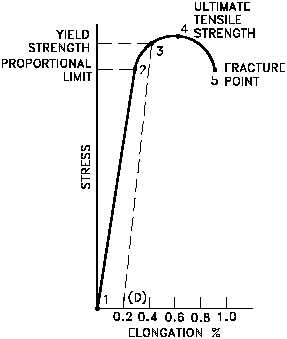PHYSICAL PROPERTIES
DOE-HDBK-1017/1-93
Properties of Metal
A straight line is drawn through Point (D)
Figure 5 Typical Brittle Material Stress-Strain Curve
at the same slope as the initial portion of
the stress-strain curve.
The point of
intersection of the new line and the stress-
strain curve is projected to the stress axis.
The stress value, in pounds per square
inch, is the yield strength. It is indicated
in Figure 5 as Point 3. This method of
plotting is done for the purpose of
subtracting the elastic strain from the total
strain,
leaving
the
predetermined
"permanent offset" as a remainder. When
yield strength is reported, the amount of
offset used in the determination should be
stated. For example, "Yield Strength (at
0.2% offset) = 51,200 psi."
Some examples of yield strength for metals are as follows.
Aluminum
3.5 x 104 to 4.5 x 104 psi
Stainless steel
4.0 x 104 to 5.0 x 104 psi
Carbon steel
3.0 x 104 to 4.0 x 104 psi
Alternate values are sometimes used instead of yield strength. Several of these are briefly
described below.
The yield point, determined by the divider method, involves an observer
with a pair of dividers watching for visible elongation between two gage
marks on the specimen. When visible stretch occurs, the load at that
instant is recorded, and the stress corresponding to that load is calculated.
MS-02
Page 22
Rev. 0


